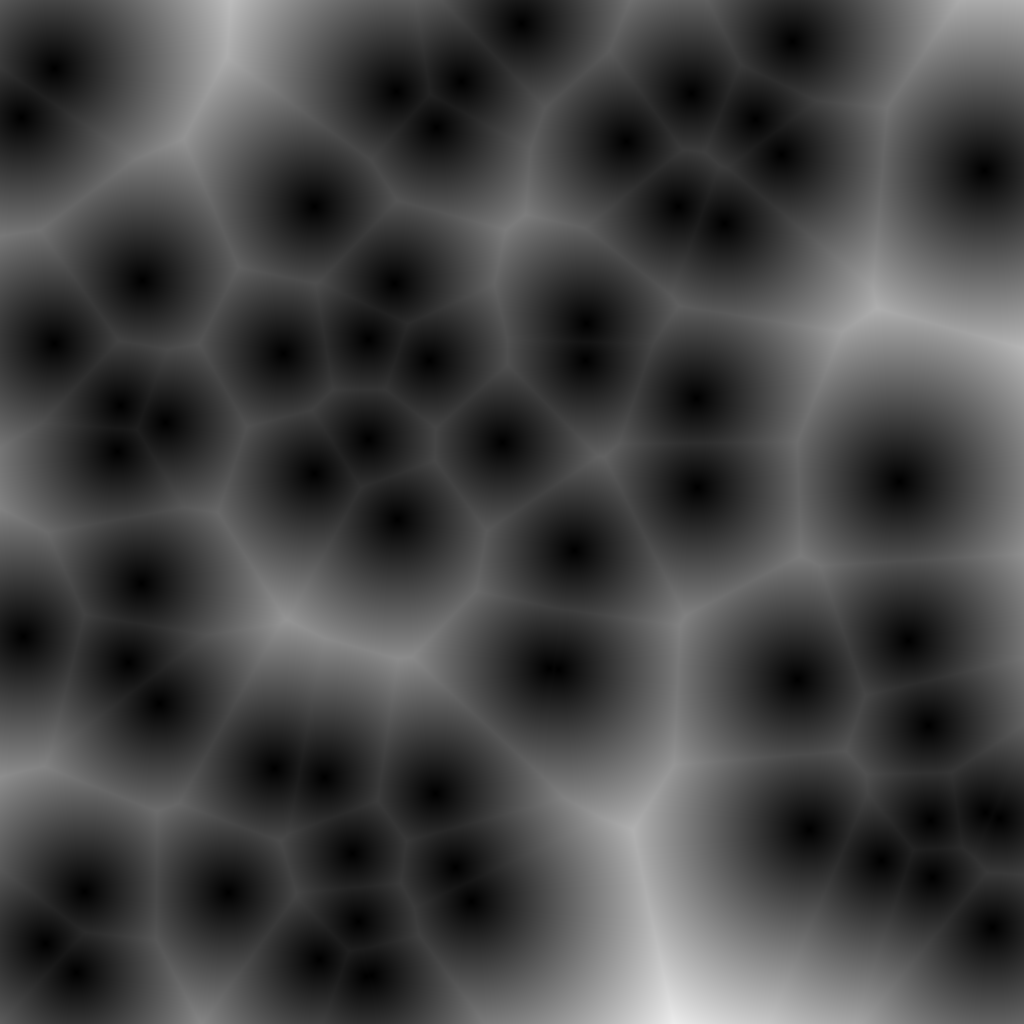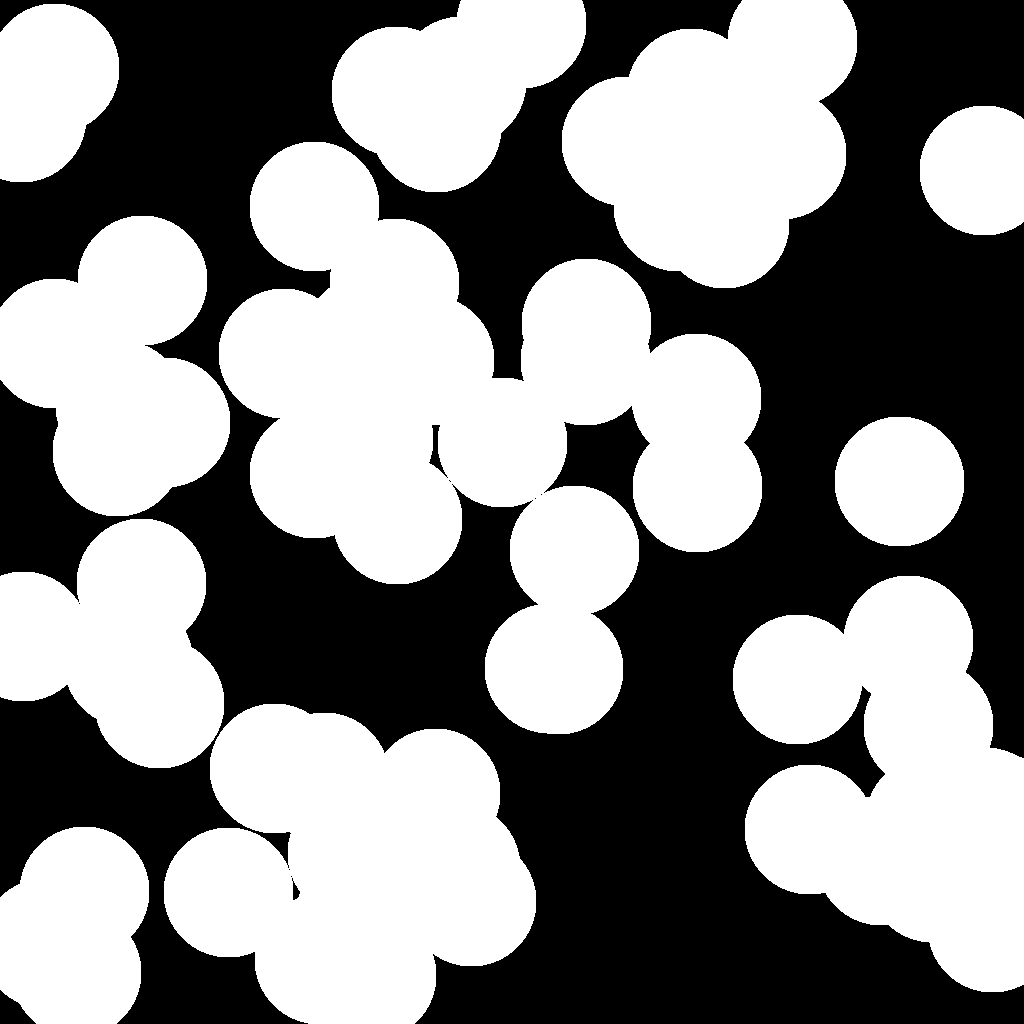Generating Voronoi Noise
Voronoi Diagrams always seemed to me like a weird stepchild of noise and signed distance fields.
The process of creating a Voronoi diagram is not terribly complicated and it consists of two steps:
- Pick N random points and colors
- For each pixel find the closest point relative to it and use its color
- Profit!
Talk is cheap, so let’s take a look at the code, starting with the first step of picking N random points and colors as one might expect.
typedef union
{
uint32_t value;
struct
{
uint32_t r : 8;
uint32_t g : 8;
uint32_t b : 8;
uint32_t a : 8;
};
} rgba_t;
typedef struct
{
int x;
int y;
rgba_t rgba;
} point_t;
static void randomize(
point_t *points,
const int n,
const int w,
const int h,
const unsigned int seed
)
{
point_t *p, *e;
const int ww = w - 16;
const int hh = h - 16;
srand(seed);
for(p = points, e = points + n; p != e; p++)
{
p->x = (rand() % ww) + 8;
p->y = (rand() % hh) + 8;
p->rgba = (rgba_t) {
.r = ((rand() & 127) + 64),
.g = ((rand() & 127) + 32),
.b = ((rand() & 127) + 64),
.a = 0xFF
};
}
}
And then the actual part where the magic happens.
static inline unsigned int distance(
const point_t *p,
const int x,
const int y
)
{
const int dx = p->x - x;
const int dy = p->y - y;
return dx * dx + dy * dy;
}
static void process(
const point_t *points,
const int n,
rgba_t *restrict output,
const int w,
const int h
)
{
int x, y, yo;
unsigned int d, cd;
const point_t *cp, *p, *e = points + n;
for(y = 0; y < h; y++)
{
yo = y * w;
for(x = 0; x < w; x++)
{
cd = UINT_MAX;
cp = points;
for(p = points; p != e; p++)
{
d = distance(p, x, y);
if(d < cd)
{
cd = d;
cp = p;
}
}
output[x + yo] = cp->rgba;
}
}
}
Voilà!

Worley Noise
What if instead of using random colors we used the distance to the point as the actual color?
That’s exactly what the so called Worley Noise is all about.
Before taking a look at the code, let’s see the results first in order to switch things up a wee bit.

The modifications to the process function can be seen below. The only thing worth calling out is the fact that we only take the sqrt of the distance once, which is still going to be expensive but it’s not end of the world.
static void process(
const point_t *points,
const int n,
rgba_t *restrict output,
const int w,
const int h
)
{
int x, y, yo;
unsigned int d, cd;
const point_t *p, *e = points + n;
for(y = 0; y < h; y++)
{
yo = y * w;
for(x = 0; x < w; x++)
{
cd = UINT_MAX;
for(p = points; p != e; p++)
{
d = distance(p, x, y);
if(d < cd)
{
cd = d;
}
}
cd = sqrt(cd);
output[x + yo] = (rgba_t) {
.r = cd,
.g = cd,
.b = cd,
.a = 0xFF
};
}
}
}
Obviously, instead of picking random points, we could also place points on a grid an then simply displace them in order to have more fine grained control. Also, the distance could be manipulated in a gazillion ways in order to customize and alter the output even further.
Let’s take a quick look at what happens if we apply a simple step function.
#define step(a, b) ((a) < (b) ? 0 : 1)
cd = step(64, cd) * 0xFF;

Metaballs anyone?
Source Code
You can find the full source code below as per usual.
/*
MIT LICENSE
Copyright (c) 2023, Mihail Szabolcs
*/
#include <stdbool.h>
#include <stdint.h>
#include <stdlib.h>
#include <stdio.h>
#include <limits.h>
#include <math.h>
#include <time.h>
#define STB_IMAGE_WRITE_IMPLEMENTATION
#include "stb_image_write.h"
#ifndef UNUSED
#define UNUSED(x) (void)(x)
#endif
#define DEFAULT_SIZE 1024
#define DEFAULT_NUM_POINTS 64
#define min(a, b) ((a) < (b) ? (a) : (b))
#define max(a, b) ((a) > (b) ? (a) : (b))
#define clamp(x, a, b) max(a, min(b, x))
#define step(a, b) ((a) < (b) ? 0 : 1)
typedef union
{
uint32_t value;
struct
{
uint32_t r : 8;
uint32_t g : 8;
uint32_t b : 8;
uint32_t a : 8;
};
} rgba_t;
typedef struct
{
int x;
int y;
#ifdef COLORS
rgba_t rgba;
#endif
} point_t;
static void randomize(
point_t *points,
const int n,
const int w,
const int h,
const unsigned int seed
);
static void process(
const point_t *points,
const int n,
rgba_t *restrict output,
const int w,
const int h
);
int main(int argc, char *argv[])
{
int w, h, n, ret;
unsigned int seed;
rgba_t *output;
point_t *points;
if(argc < 2)
{
fprintf(
stderr,
"usage: %s output.png [[size] [num points] [seed]]\n",
argv[0]
);
return EXIT_FAILURE;
}
if(argc > 2)
{
w = clamp(atoi(argv[2]), 64, 4096);
h = w;
}
else
{
w = DEFAULT_SIZE;
h = DEFAULT_SIZE;
}
if(argc > 3)
n = clamp(atoi(argv[3]), 1, 4096);
else
n = DEFAULT_NUM_POINTS;
if(argc > 4)
seed = atoi(argv[4]);
else
seed = time(NULL);
output = malloc(w * h * sizeof(rgba_t));
if(output == NULL)
{
fprintf(stderr, "failed to allocate memory for output image\n");
return EXIT_FAILURE;
}
points = malloc(n * sizeof(point_t));
if(points == NULL)
{
fprintf(stderr, "failed to allocate memory for pointsn");
free(output);
return EXIT_FAILURE;
}
randomize(points, n, w, h, seed);
process(points, n, output, w, h);
ret = stbi_write_png(
argv[1],
w,
h,
sizeof(rgba_t),
output,
w * sizeof(rgba_t)
);
if(ret == 0)
{
fprintf(stderr, "failed to write output image: '%s'\n", argv[1]);
ret = EXIT_FAILURE;
}
else
{
fprintf(stdout, "wrote output image to '%s' ...\n", argv[1]);
ret = EXIT_SUCCESS;
}
free(points);
free(output);
return ret;
}
static void randomize(
point_t *points,
const int n,
const int w,
const int h,
const unsigned int seed
)
{
point_t *p, *e;
const int ww = w - 16;
const int hh = h - 16;
srand(seed);
for(p = points, e = points + n; p != e; p++)
{
p->x = (rand() % ww) + 8;
p->y = (rand() % hh) + 8;
#ifdef COLORS
p->rgba = (rgba_t) {
.r = ((rand() & 127) + 64),
.g = ((rand() & 127) + 32),
.b = ((rand() & 127) + 64),
.a = 0xFF
};
#endif
}
}
static inline unsigned int distance(
const point_t *p,
const int x,
const int y
)
{
const int dx = p->x - x;
const int dy = p->y - y;
return dx * dx + dy * dy;
}
static void process(
const point_t *points,
const int n,
rgba_t *restrict output,
const int w,
const int h
)
{
int x, y, yo;
unsigned int d, cd;
const point_t *p, *e = points + n;
#ifdef COLORS
const point_t *cp;
#endif
for(y = 0; y < h; y++)
{
yo = y * w;
for(x = 0; x < w; x++)
{
cd = UINT_MAX;
#ifdef COLORS
cp = points;
#endif
for(p = points; p != e; p++)
{
d = distance(p, x, y);
if(d < cd)
{
cd = d;
#ifdef COLORS
cp = p;
#endif
}
}
#ifdef COLORS
output[x + yo] = cp->rgba;
#else
cd = sqrt(cd);
// cd = step(STEP, cd) * 0xFF;
output[x + yo] = (rgba_t) {
.r = cd,
.g = cd,
.b = cd,
.a = 0xFF
};
#endif
}
}
}
/* vim: set ts=4 sw=4 sts=4 noet: */

2023-12-06